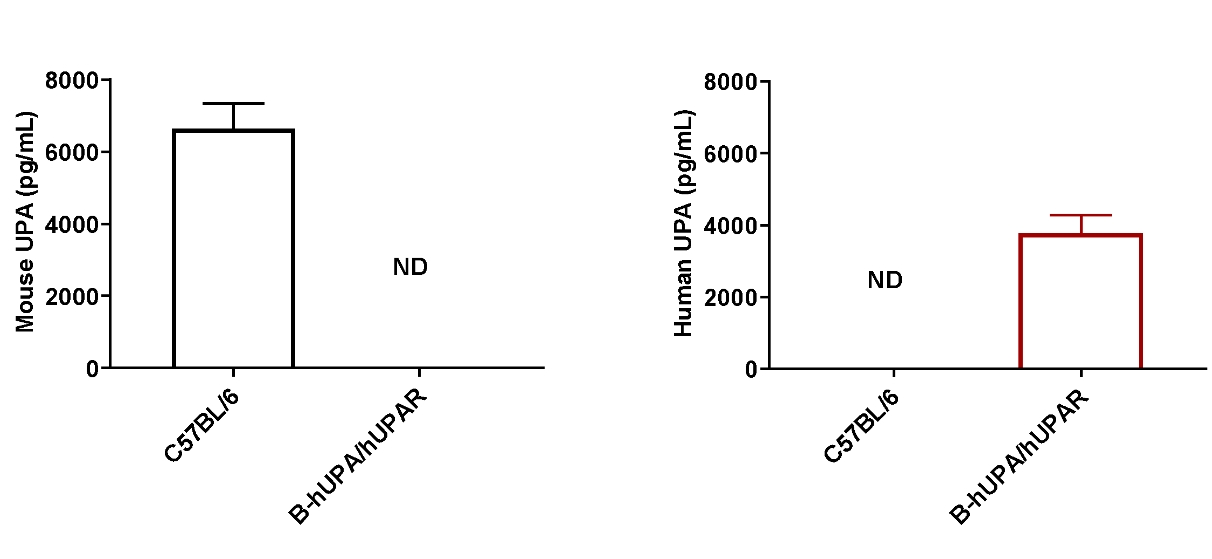Basic Information
-
Gene targeting strategy

-
Gene targeting strategy. The full coding region of mouse Upa gene was replaced by human UPA coding region sequences in B-hUPA/hUPAR mice. The coding region except signal peptide of mouse Upar gene was replaced by human UPAR counterpart gene sequences in B-hUPA/hUPAR mice.
-
Protein expression analysis

-

Strain specific UPA expression analysis in homozygous B-hUPA/hUPAR mice by ELISA. Serum was collected from wild-type C57BL/6 mice and homozygous B-hUPA/hUPAR mice (male, 9-week-old, n=3), and analyzed by ELISA with species-specific UPA ELISA kit. Mouse UPA were detectable in wild-type C57BL/6 mice. Human UPA was exclusively detectable in homozygous B-hUPA/hUPAR mice but not in wild-type mice.


Strain specific UPAR (also named PLAUR) expression analysis in homozygous B-hUPA/hUPAR mice by flow cytometry. Bone marrow were collected from wild-type C57BL/6 mice (+/+) and homozygous B-hUPA/hUPAR mice (H/H), and analyzed by flow cytometry with species-specific anti-UPAR antibody. Mouse UPAR was only detectable in in dendritic cells of wild-type mice. Human UPAR were exclusively detectable in mono/macrophages, granulocytes, and dendritic cells of homozygous B-hUPA/hUPAR mice but not in wild-type mice.
-
In vivo efficacy of anti-PLAUR antibodies

-

Antitumor activity of anti-UPAR antibodies in B-hUPA/hUPAR mice bearing B-hUPAR MC38 cells. (A) Tumor growth in B-hUPA/hUPAR mice that treated with anti-UPAR antibodies (in house) indicated in the panel. (B) Body weight changes during treatment. Murine colon cancer MC38 cells that express the human UPAR protein were subcutaneously implanted into homozygous B-hUPA/hUPAR mice (female, 7-9 week-old, n=6). Mice were grouped when tumor volume reached approximately 100 mm3, at which time they were treated with antibodies. Values are expressed as mean ± SEM.

Antitumor activity of anti-UPAR antibodies in B-hUPA/hUPAR mice bearing B-hUPAR MC38 cells. Tumor growth curve in individual B-hUPA/hUPAR mice that treated with anti-UPAR antibodies (in house) indicated in the panel.
-
Binding assay of anti-PLAUR antibodies with B-hPLAU/hPLAUR mice

-

Analysis the binding of anti-human UPAR antibodies with B-hUPA/hUPAR mice by flow cytometry. Macrophages in ascites of B-hUPA/hUPAR mice were performed to assess anti-human UPAR antibodies (in house) binding. Both antibodies bind well with human UPAR in homozygous mice.
Anti-human UPAR Ab1: binding UPAR Domain 1
Anti-human UPAR Ab2: binding UPAR Domain 2+Domain 3
-
Summary

-
- Protein expression analysis:
- Human UPA was exclusively detectable in homozygous B-hUPA/hUPAR mice but not in wild-type mice.
- Human UPAR were exclusively detectable in mono/macrophages, granulocytes, and dendritic cells of homozygous B-hUPA/hUPAR mice but not in wild-type mice.
- In vivo efficacy study
B-hUPAR MC38 cells were able to establish tumors in B-hUPA/hUPAR mice in vivo and can be used for efficacy studies of anti-human UPAR antibodies.


